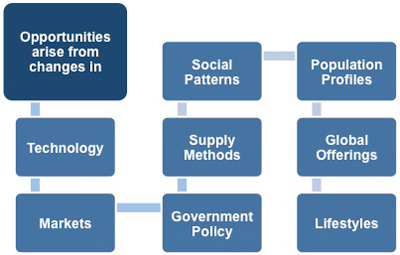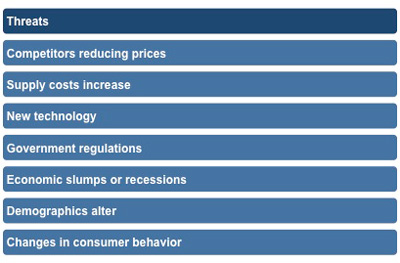External Analysis - Opportunities and Threats

External factors include the environment your organization operates in, its market, ecosystem, and all of the third parties involved.
 |
The market refers to the market sector you supply your goods or services to even if this is done on a not-for-profit basis. It includes all of your customers.
The ecosystem is something that exists beyond the market per se and includes current and future technologies as well as current and proposed business models. For example, the ecosystem in which book publishing exists consists of high street bookshops, non-specialist retailers (supermarkets etc.), online book retailers (Amazon, Smashwords, etc.), as well as libraries and other places where people can obtain books.
It also encompasses the technologies available, including those still in their infancy like 'printing on demand.' These new technologies can destabilize your existing business strategy if they are ignored or disparaged simply because they are as yet unproven. Aside from technology, the ecosystem includes the social, economic, and political environment that you operate in.
Third parties are all of the other entities you deal with who are not your customers (and therefore part of the 'market'). They include your suppliers, partners, and competitors, and may also include government and regulatory bodies, the media, or any other group that you need to deal with in the course of doing business.
The ecosystem can also be analyzed using the PESTLE analysis technique, which focuses on macro-environmental variables. If you are unfamiliar with the PESTLE technique or you want to understand it in greater detail then download our free PESTLE Analysis eBook.
As you identify these external factors you should classify them into potential opportunities or threats.
Opportunities
Opportunities can occur for a variety of reasons and may result from changes within the market, customer lifestyle changes, advances in technology, new production methods, etc.
 |
These opportunities for growth can also occur from a resolution of a problem associated with your current product. For example, Skoda's market share rose considerably once its cars were known to be reliable.
Successful organizations are constantly reviewing their market and services to see how they can increase their market share. Opportunities have a wide variety of origins as shown in the diagram above.
In recent years, the increased pace of technological change has enabled many organizations to achieve rapid growth using outsourcing and off-shoring.
Alterations in the structure of markets along with changing social and lifestyle patterns also provide opportunities for expansion. For example,
Most supermarkets provide a vast range of everyday products from books to power tools. Having begun as little more than large grocery stores, they have taken the opportunities offered by changing lifestyles to meet the need of one-stop shopping by people of both sexes who work full time and prefer to buy everything they need from as few shops as possible.
Another area that can serve as a source of opportunistic growth is that of changes to government policy or regulations. For example,
In the UK the deregulation of utilities such as gas, electricity, and water enabled utilities organizations to have the freedom to offer their clients any service or product they felt was worthwhile, which has led to water companies selling insurance and electricity companies supplying domestic gas.
Also, the changes in legislation throughout the European Union that made it compulsory for children under a certain height or age to have a car seat offered anyone manufacturing these products a significant growth opportunity.
All of the opportunities you identify in the SWOT analysis will be external to your organization and some may be time limited. For example,
When the European Union passed legislation forcing all suppliers of electrical goods to comply with new waste disposal legislation by January 2007, this created a short-term opportunity for companies that offered consultancy services in this area.
As you work through this external analysis part of the SWOT process you must be aware that what is seen as an opportunity in one market or for one product or service may be considered a threat for another.
Threats
The final part of the SWOT process involves assessing the external risks your organization faces. These are referred to as threats and are made up of external factors that are beyond your control.
Even though they are external, which means that you have little or no control over them, your organization should consider making contingency plans, no matter how sketchy. This will ensure that you are not taken completely by surprise, but perhaps more importantly, it can put items 'on the agenda' for discussion that people may be more comfortable ignoring.
The greater your ability to identify potential threats the more proactive you will be able to be in your planning for and responding to such events. Anticipating and responding to your competitors' actions is one of the biggest challenges your organization has to face and clearly indicates the need for gathering good market intelligence.
 |
Other significant threats are those associated with the supply chain. For example, your suppliers could increase their prices, transport costs, or terms and conditions in a way that is harmful to you. This change may come about because of a change in their own external environment, such as increasing raw material costs or labor costs.
Changes within the market itself can pose a threat to your organization, such as a new market entrant who significantly alters the product offering. For example, Apple's iTunes and Spotify radically changed the market for recorded music.
There may also be unexpected changes in consumer behavior that can significantly impact your product sales. For example, the almost universal social acceptance of copyright theft in the form of illegal downloading has meant that something that was once a minority activity is now ubiquitous. The important point here is not that the enabling technology became available but that so many people who would never normally take something without paying for it now routinely do exactly that. These types of change in behavior are almost impossible to predict, can be quite sudden, and have far reaching consequences.
Other potential threats are far more predictable - for example the effects of the economic cycle. Developed economies routinely undergo what are popularly known as 'boom and bust' phases. Discussing the threat of economic recession can seem unnecessarily pessimistic when the economy is booming, but investment in new capacity and product development is always most tempting at the top of the boom, exactly when it represents the biggest threat.
Identifying potential threats is a key part of the SWOT analysis. During this stage of the process individuals should not be hesitant in bringing their worst fears to the discussions. Some issues may be highly speculative but debating them adds value to the SWOT analysis.
When assessing the likelihood of either of these external aspects many organizations use a matrix for the opportunities and threats that compares the probability of it happening with the impact it may have on the organization. You can apply a score to each issue, and where this factor has a high score on both the likelihood of it occurring and the likely impact on the organization it should be investigated thoroughly.
You may also be interested in: Definition of SWOT Analysis, Strengths, Weaknesses, Opportunities, and Threats, Internal Factors (Strengths and Weaknesses), External Factors (Opportunities and Threats), Matching and Converting, Advantages and Disadvantages and SWOT Analysis Example.



